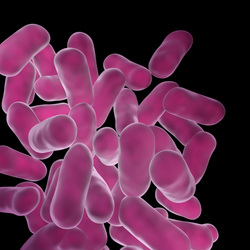 Bacillus seen using electron microscopy
Bacillus seen using electron microscopy Bacteria:
As small prokaryotic (no cell nucleus or organelles), bacteria form the "backbone" of the wastewater treatment plant in that they are the most common organisms and they do most of the work in converting pollutants into non-hazardous forms. The species vary according to system temperature, pH, inlet chemical makeup, dissolved oxygen, and other environmental factors. Usually we classify wastewater bacteria based on their ability to grow under various temperatures (psychrophiles, mesophiles, thermophiles) and the ability to utilize oxygen or other electron acceptor for cellular respiration (aerobic, facultative anaerobic, obligate anaerobe).
Fungi:
A more complex organism than bacteria, Fungi can be unicellular (yeasts) or multicellular with hyphae. In waste treatment we usually have higher concentrations of fungi under low pH conditions (pH <5.0). Other factors that can favor fungi include complex organics (lignin and other complex biopolymers) and low concentration of macronutrients (nitrogen & phosphorus). Usually fungi are found in much lower concentrations than bacteria in wastewater.
Archaea:
Once classified as an unusual bacteria group, over the past 20 years scientists have moved archaea into a separate kingdom. Possessing unique cell membranes and chemistry, archaea microbes are found in such environments as ocean thermal vents, hot springs, anaerobic digesters, ruminant digestive systems, and other diverse environments. In waste treatment we most often see archaea in methane producing microbes in anaerobic digesters. These methanogens, produce methane from short-chain organic acids and H2 which are produced by facultative and obligate anaerobic bacteria. The activity of the methanogens is vital for COD/BOD reduction in anaerobic digesters and for production of methane gas. Most other archaea are found in low concentrations in wastewater treatment plants and are secondary to bacteria in importance.

 RSS Feed
RSS Feed